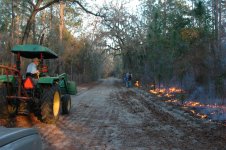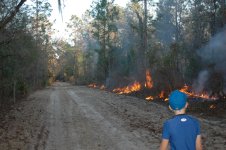Rainy, dreary Saturday morning . . . good time for an oddball discussion.
Pitch pine is, I think, another term used to describe what I'm talking about. It is the heartwood from certain types of Southern Yellow Pine, notably Longleaf, and to a lessor extent, Loblolly. Most of those pine trees you see on the Augusta National Golf Course are Loblolly. Two hundred years ago, one would have seen a lot of Longleaf pine. Longleaf is a slow-growing variety that is very fire resistant. It has seen a resurgence of popularity in recent years. I have seen Longleaf plantations that look as if they had been burned to a crisp. I mean 10 ft tall trees with all the needles burned off them. A year later, these stands are healthy and have grown rapidly . . . the fire actually stimulates them, I think. Loblolly is fire resistant, but not to the extent that Longleaf is. In the late 18th, 19th, and early 20th Centuries, many, many boatloads and trainloads of Longleaf were shipped overseas and "up North." The old Sears Building in Chicago was constructed using Longleaf harvested in Louisiana.
~ Hartvigson's: Antique Heart Pine History and Significance ~
I have always loved the look of Heart Pine. I have floors in one house made from timbers that were salvaged from an old school building in the county, probably constructed in the 1890s. My wife's farmstead has a bunch of buildings that range from 150+ years old, up to the turn of the 20th Century. Some are standing, and we have salvaged wood from a couple and turned it into floors, wall paneling, etc.
Most of our wood is probably from Loblolly pine rather than Longleaf, and it contains both sapwood and Heartwood.
They say a picture is worth a thousand words:
Lightard Stump. The tree was probably cut fifty years ago.

Lightard fence post. No telling how long it has been in the ground. I would guess minimum sixty-plus years. It is still solid.

These are fair examples of lightard knots. I picked them up in the woods today. They occur where a limb branches from the trunk or from a larger branch. For some reason, resin is more concentrated there. when the sapwood rots, often all that is left is a "lightard knot".

Old buildings such as the one these doors are on are built mostly of fat lightard. This barn is probably 125 years old or older. If you have ever seen one of these structures burn, you know what a black smoke they put up and how quickly they are consumed.

This is a "heart pine" floor. Same as lightard. Before planing, sanding, and several coats of clear polyurethane (no stain, just clear), these boards looked very much like the boards in the old doors in the previous picture. The darker board where the floor transitions to tile is particularly interesting because you can see the old saw-kerf marks. These boards came off an old chicken coop and barn on the place. The darker boards have more heart, the lighter ones more sapwood.

Heart Pine table built for us by "Buzzy" Smith from Americus. The table is set for Thanksgiving Dinner.

All these pictures were made on my wife's farm here in North Taylor County. As you can see, we love our "fat lightard" floors and furniture.
Pitch pine is, I think, another term used to describe what I'm talking about. It is the heartwood from certain types of Southern Yellow Pine, notably Longleaf, and to a lessor extent, Loblolly. Most of those pine trees you see on the Augusta National Golf Course are Loblolly. Two hundred years ago, one would have seen a lot of Longleaf pine. Longleaf is a slow-growing variety that is very fire resistant. It has seen a resurgence of popularity in recent years. I have seen Longleaf plantations that look as if they had been burned to a crisp. I mean 10 ft tall trees with all the needles burned off them. A year later, these stands are healthy and have grown rapidly . . . the fire actually stimulates them, I think. Loblolly is fire resistant, but not to the extent that Longleaf is. In the late 18th, 19th, and early 20th Centuries, many, many boatloads and trainloads of Longleaf were shipped overseas and "up North." The old Sears Building in Chicago was constructed using Longleaf harvested in Louisiana.
~ Hartvigson's: Antique Heart Pine History and Significance ~
I have always loved the look of Heart Pine. I have floors in one house made from timbers that were salvaged from an old school building in the county, probably constructed in the 1890s. My wife's farmstead has a bunch of buildings that range from 150+ years old, up to the turn of the 20th Century. Some are standing, and we have salvaged wood from a couple and turned it into floors, wall paneling, etc.
Most of our wood is probably from Loblolly pine rather than Longleaf, and it contains both sapwood and Heartwood.
They say a picture is worth a thousand words:
Lightard Stump. The tree was probably cut fifty years ago.

Lightard fence post. No telling how long it has been in the ground. I would guess minimum sixty-plus years. It is still solid.

These are fair examples of lightard knots. I picked them up in the woods today. They occur where a limb branches from the trunk or from a larger branch. For some reason, resin is more concentrated there. when the sapwood rots, often all that is left is a "lightard knot".

Old buildings such as the one these doors are on are built mostly of fat lightard. This barn is probably 125 years old or older. If you have ever seen one of these structures burn, you know what a black smoke they put up and how quickly they are consumed.

This is a "heart pine" floor. Same as lightard. Before planing, sanding, and several coats of clear polyurethane (no stain, just clear), these boards looked very much like the boards in the old doors in the previous picture. The darker board where the floor transitions to tile is particularly interesting because you can see the old saw-kerf marks. These boards came off an old chicken coop and barn on the place. The darker boards have more heart, the lighter ones more sapwood.

Heart Pine table built for us by "Buzzy" Smith from Americus. The table is set for Thanksgiving Dinner.

All these pictures were made on my wife's farm here in North Taylor County. As you can see, we love our "fat lightard" floors and furniture.




